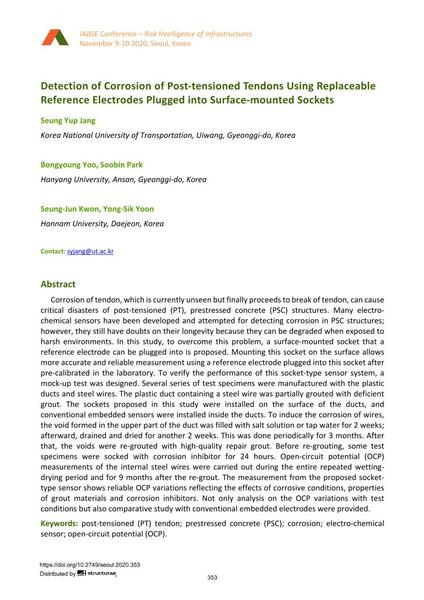Detection of Corrosion of Post-tensioned Tendons Using Replaceable Reference Electrodes Plugged into Surface-mounted Sockets

|
|
|||||||||||
Détails bibliographiques
| Auteur(s): |
Seung Yup Jang
(Korea National University of Transportation, Uiwang, Gyeonggi-do, Korea)
Bongyoung Yoo (Hanyang University, Ansan, Gyeonggi-do, Korea) Soobin Park (Hanyang University, Ansan, Gyeonggi-do, Korea) Seung-Jun Kwon (Hannam University, Daejeon, Korea) Yong-Sik Yoon (Hannam University, Daejeon, Korea) |
||||
|---|---|---|---|---|---|
| Médium: | papier de conférence | ||||
| Langue(s): | anglais | ||||
| Conférence: | IABSE Conference: Risk Intelligence of Infrastructures, Seoul, South Korea, 9-10 November 2020 | ||||
| Publié dans: | IABSE Conference Seoul 2020 | ||||
|
|||||
| Page(s): | 353-357 | ||||
| Nombre total de pages (du PDF): | 5 | ||||
| DOI: | 10.2749/seoul.2020.353 | ||||
| Abstrait: |
Corrosion of tendon, which is currently unseen but finally proceeds to break of tendon, can cause critical disasters of post-tensioned (PT), prestressed concrete (PSC) structures. Many electro- chemical sensors have been developed and attempted for detecting corrosion in PSC structures; however, they still have doubts on their longevity because they can be degraded when exposed to harsh environments. In this study, to overcome this problem, a surface-mounted socket that a reference electrode can be plugged into is proposed. Mounting this socket on the surface allows more accurate and reliable measurement using a reference electrode plugged into this socket after pre-calibrated in the laboratory. To verify the performance of this socket-type sensor system, a mock-up test was designed. Several series of test specimens were manufactured with the plastic ducts and steel wires. The plastic duct containing a steel wire was partially grouted with deficient grout. The sockets proposed in this study were installed on the surface of the ducts, and conventional embedded sensors were installed inside the ducts. To induce the corrosion of wires, the void formed in the upper part of the duct was filled with salt solution or tap water for 2 weeks; afterward, drained and dried for another 2 weeks. This was done periodically for 3 months. After that, the voids were re-grouted with high-quality repair grout. Before re-grouting, some test specimens were socked with corrosion inhibitor for 24 hours. Open-circuit potential (OCP) measurements of the internal steel wires were carried out during the entire repeated wetting- drying period and for 9 months after the re-grout. The measurement from the proposed socket- type sensor shows reliable OCP variations reflecting the effects of corrosive conditions, properties of grout materials and corrosion inhibitors. Not only analysis on the OCP variations with test conditions but also comparative study with conventional embedded electrodes were provided. |
||||
